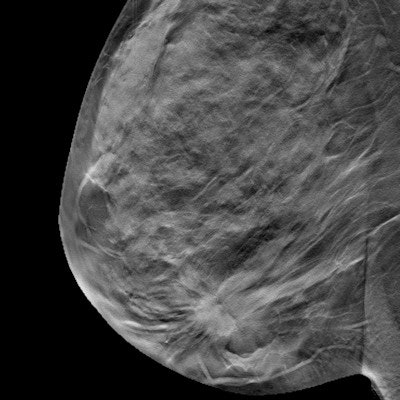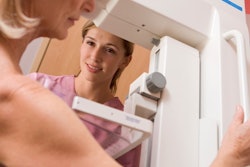
In a substudy of a large digital breast tomosynthesis (DBT) trial, Italian researchers found screen reading using DBT with either acquired or synthesized 2D mammography generally improved breast cancer detection compared with 2D mammography alone but also increased false-positive recalls.
The results come from the Screening with Tomosynthesis Or Standard Mammography-2 (STORM-2) trial, in which researchers measured the effect of integrating DBT in screen reading alongside acquired or synthesized 2D mammograms. To create a synthesized 2D mammogram, 3D data acquired from DBT is reconstructed into a 2D mammogram. Lead author Dr. Daniela Bernardi from the radiology department at U.O. Senologia Clinica & Screening Mammografico in Trento, Italy, and colleagues found DBT increased cancer detection and false positives for most readers (European Journal of Radiology, September 2018, Vol. 106, pp. 26-31).
The findings "highlight variability in the extent that adding [DBT] affects radiologists' interpretation of screening mammograms," the study authors wrote. "We found variability in the magnitude of effect from integrating [DBT] in screening (relative to acquired or synthesized 2D mammography) on individual radiologist's true-positive and false-positive detection."
However, there was an overall similar pattern of increasing cancer detection and also increasing false-positive recall for most readers, they added.
Trial specifics
Researchers continue to evaluate the efficacy of DBT to improve breast cancer detection. In the present study, Bernardi and colleagues focused on reader-specific interpretation in STORM-2 to elucidate the effect of integrating DBT (Selenia Dimensions, Hologic) in screening practice on individual radiologists' detection capability.
Previous research has provided little information on reader-specific data or has reported interim analyses -- something Bernardi and her team sought to rectify to identify potential variability in the effect of integrating DBT in screening.
The researchers recruited asymptomatic women ages 49 and older years who attended population-based screening in Trento. Clinicians recalled patients at any positive sequential screen read in either reading arm of the trial. Radiologist-specific detection measures were calculated for each of seven radiologists who performed screen reads: number of detected cancers, proportion of true-positive detection, and number and rate of false-positive recalls. They estimated incremental cancer detection rate from integrating DBT in screen reading.
| DBT vs. 2D mammography in Trento | ||||
| 2D mammography | Integrated 2D mammography/DBT | 2D synthetic | 2D synthetic mammography/DBT | |
| True-positive detection range | 46% to 100% (median 59.5%) |
75% to 100% (median 76%) | 56% to 76% (median 64%) | 67% to 88% (median 78%) |
| False-positive recalls range | 1.2% to 2.7% (median 2.25%) |
1.5% to 3.4% (median 2.75%) | 1.6% to 4.6% (median 2.4%) | 1.8% to 6.7% (median 3.0%) |
In another finding, integrating DBT led to incremental cancer detection rates between 0 in 1,000 and 3.5 if n 1,000 screens.
"For the majority of radiologists in the STORM-2 trial, integrating [DBT] increased breast cancer detection, allowing readers to achieve better relative sensitivity than screen reading with acquired or synthesized 2D mammography alone, and the data suggest that the magnitude of improved sensitivity may be highest for the radiologists who had relatively modest cancer detection at 2D alone," the authors wrote.
The variability in the effect of DBT on radiologists' detection is also reflected in estimates of incremental cancer detection rate, although interpretation of these results should note the relatively wide confidence intervals. Plus, when DBT was integrated into screen reading, the variability in screening sensitivity between readers was less marked than seen at 2D mammography alone.
Regarding false positives, although the increase was modest for most radiologists and aligned with the trial's primary results, the finding appears to contradict results of other studies that have shown a reduction in recall from DBT screening.
"However, the effect of screening with [DBT] on recall and false positives has been heterogeneous especially for the prospective trials of this technology," the researchers noted. "Also, as pointed out in our first report of the STORM-2 trial, we believe that the sequential screen reading used in the trial to enable within-participant comparisons may have contributed to the higher false-positive recall at the DBT screen-reading phase, and anticipate that upfront screen reading of all 2D and DBT images would yield fewer false positives."
Also, with more experience reading synthesized 2D mammograms, the false-positive recall rate should go down.
"What is clearly shown in our results is there is a trade-off between increasing cancer detection (true-positive detection) and false-positive detection from integrating DBT in screening, and that trade-off varies across radiologists with some achieving similar numbers of true-positive and false-positive detection and others adding much more false-positive than true-positive detection when screen reading using DBT," they added.
Future research could explore these findings in studies in which individual readers have interpreted a larger sample of screens than in STORM-2, the researchers concluded.
Study disclosures
Dr. Bernardi received conference travel support from Hologic; all other authors have no conflicts of interest to disclose.



















